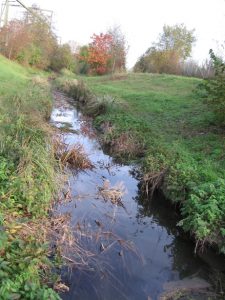In this post, Mirco Bundschuh talks about their recently published paper “Mitigation of fungicide pollution in detention ponds and vegetated ditches within a vine-growing area in Germany”.

Vegetated ditch in the agricultural landscape (photo by M. Bundschuh)
In the agricultural landscape, freshwater systems are often exposed towards a suit of agrochemicals including pesticides and nutrients. Wetlands (vegetated systems) have been proposed as a risk mitigation measure at the landscape level to reduce the concentration of these substances. In recent years, however, research has mainly focused on the efficiency of wetlands to reduce the load of nutrients but also hydrophobic insecticides, while hydrophilic fungicides have largely been ignored. At the same time, fungicides represent in the vine-growing areas in southern Palatinate the group of pesticides with the highest application rates. Here we demonstrate that vegetated ditches and detention ponds are capable of reducing the load of fungicides and thus their associated risks for the integrity of aquatic ecosystems substantially. Moreover, the fungicide mitigation efficiency of these systems was mainly explained by the plant density and size-related properties of the vegetated systems.
This study, thus, highlights the suitability of wetlands to reduce pesticide – including fungicide – contamination in surface water bodies. Moreover, it suggests that if such constructed vegetated systems are included in the environmental management at the landscape-level, risks associated with the use of pesticides and nutrients are reduced increasing the water quality at downstream sites.
The paper was authored Mirco Bundschuh, David Elsaesser, Christoph Stang and Ralf Schulz and is published in Ecological Engineering.
Interesting post? You may also be interested in: Neglected Risks – Erosion Rills Compromise Regulatory Pesticide Exposure Assessment
